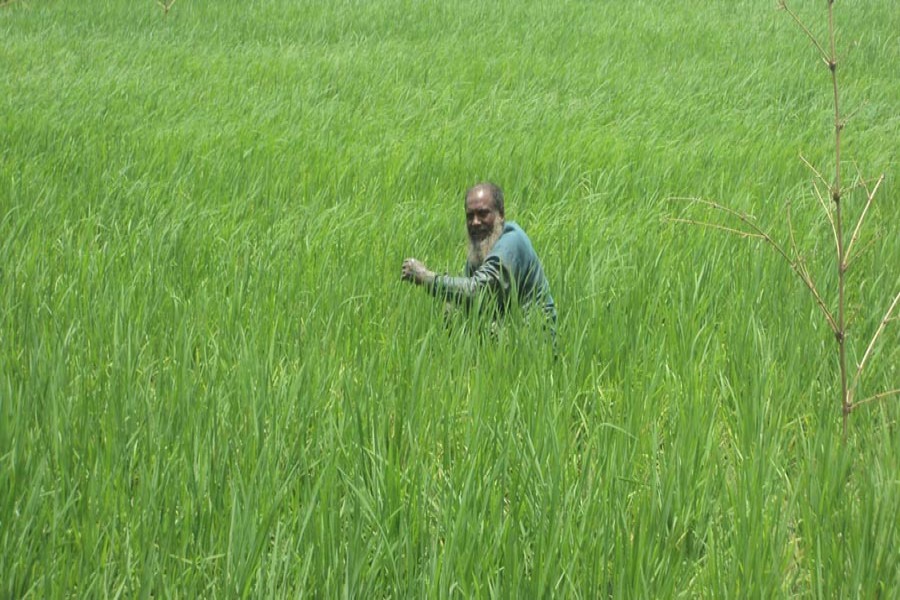Our Correspondent
BOGURA, June 30: Cultivation of two paddy varieties - Jirashail and Parija - is gaining momentum in the district this season.
Sources said the growers achieved a noticeable benefit last year from the farming of the two varieties.
Some 4,000 farmers of the district are growing Jirashail and Parija this year, sources added.
The Department of Agriculture Extension (DAE) office sources said some 5,200 hectares of land have been brought under the production of the two paddy varieties.
Jirashail and Parija can be harvested after 90 days of the plantation, said sub-assistance agriculture officer Faridur Rahman.
"I have cultivated Jirashail paddy on 10 bighas of land this season," said Shahidul Islam of Shadhu Bari village.
"I am expecting to make a profit of over Tk 0.2 million this season." he added.
Farmer Shohel Ran of Mamunshahi village said he is growing Parija on 20 bighas of land this season spending Tk 0.1 million.
The cultivator expects to achieve over 250 maunds of yield.
Upazila agriculture officer Sharmin Akhter said cultivation of both Jirashail and Parija is popular in the area.
DAE has provided all sorts of logistic support to the farmers, she added.
IN Rajshahi, farmers are now busy transplanting BRRI Dhan-48 in the vast Barind tract as part of their effort to mitigating the adverse impacts of climate change.
BRRI Dhan-48, a drought tolerant paddy variety innovated by Bangladesh Rice Research Institute (BRRI), has been gaining popularity among farmers in the Barind tract for the last couple of years.
"I got 22 maunds of paddy per bigha through cultivating the variety on two bighas of land last year," said Modaffer Ali, 43, a farmer of Koroldanga village under Shapahar upazila in Naogaon district.
Whereas, he could get hardly 10 maunds of paddy per bigha if he cultivates Parija, a conventional variety of the region.
Masud Mian, 45, another farmer of Kodomshohar village under Godagari upazila, expressed his happiness over cultivating the variety saying its average yield is from 15 to 23 maunds per bigha.
He mentioned that the conventional parija variety is being replaced by the new variety which is a good sign for the region in terms of boosting yield.
All the government organisations concerned are promoting the variety in the Barind tract as effective means of addressing the adverse impact of climate change.
The Barind Station of On-Farm Research Division (OFRD) under the Bangladesh Agriculture Research Institute (BARI) has inserted the paddy variety into its four-crop based cropping pattern in a bid to lessen the gradually mounting pressure on underground water in the drought-prone area.
Dr Shakhawat Hossain, team leader of OFRD (Barind Station), said there has been an enormous prospect of bringing harvesting intensity coupled with increasing food production through a successful promotion of the Aush-Aman-Lentil-Mungbean cropping pattern.
To maintain sound soil health, it could be advisable to grow rice especially Brridhan48 using a different system in order to improve compatibility between monsoon rice and upland winter crops.
The newly innovated paddy variety has opened up a door of enormous prospects for food security along with mitigating the crises of irrigation water.
It has been giving satisfactory yield with scanty rainfall and limited irrigation during the Aush season in the area. This would also go well with a shift in economic importance of the winter crops over monsoon rice.
"We are arranging training and other motivational programmes for the farmers to adopt the cropping pattern to boost agricultural production through the best use of modern technologies to feed the gradually increasing population," he added.
Terming the development of the drought-tolerant varieties a demand of the time, Dr Hossain said that the variety has started contributing a lot to ensure food security.
Sharing their experiences, two female farmers - Nasira Begum and Nadira Begum - told BSS that the BRRI Dhan-48 variety has brought enormous benefit for them in cultivating rice in drought prone rain-fed environment.
They urged the authorities concerned to remove the existing seed crisis of the variety to encourage more other farmers towards cultivating the variety.
By virtue of early harvesting characteristics the variety supplements the farming of transplanted Aman and various Rabi crops like tomato, brinjal, mustard and vegetables as the region is conventionally famous for farming these crops abundantly.

- Wednesday, 25 December 2024 |
- Today's FE |
- e-Paper |
- Beta Website

